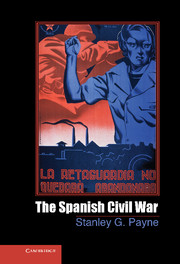Book contents
- Frontmatter
- Contents
- Chronology of Major Events
- Glossary
- Preface
- Introduction Civil War in Twentieth-Century Europe
- 1 Modernization and Conflict in Spain
- 2 From Revolutionary Insurrection to Popular Front
- 3 The Breakdown of Democracy
- 4 The Military Insurrection of the Eighteenth of July
- 5 The Battle of Madrid – the First Turning Point
- 6 Revolution
- 7 Terror
- 8 A War of Religion
- 9 Franco's Counterrevolution
- 10 Foreign Intervention and Nonintervention
- 11 Soviet Policy in Spain, 1936–1939
- 12 The Propaganda and Culture War
- 13 A Second Counterrevolution? The Power Struggle in the Republican Zone
- 14 The Decisive Northern Campaigns of 1937–1938
- 15 The War at Sea and in the Air
- 16 Civil Wars within a Civil War
- 17 The War in Perspective
- Conclusion Costs and Consequences
- Select Bibliography
- Index
- References
3 - The Breakdown of Democracy
Published online by Cambridge University Press: 05 September 2012
- Frontmatter
- Contents
- Chronology of Major Events
- Glossary
- Preface
- Introduction Civil War in Twentieth-Century Europe
- 1 Modernization and Conflict in Spain
- 2 From Revolutionary Insurrection to Popular Front
- 3 The Breakdown of Democracy
- 4 The Military Insurrection of the Eighteenth of July
- 5 The Battle of Madrid – the First Turning Point
- 6 Revolution
- 7 Terror
- 8 A War of Religion
- 9 Franco's Counterrevolution
- 10 Foreign Intervention and Nonintervention
- 11 Soviet Policy in Spain, 1936–1939
- 12 The Propaganda and Culture War
- 13 A Second Counterrevolution? The Power Struggle in the Republican Zone
- 14 The Decisive Northern Campaigns of 1937–1938
- 15 The War at Sea and in the Air
- 16 Civil Wars within a Civil War
- 17 The War in Perspective
- Conclusion Costs and Consequences
- Select Bibliography
- Index
- References
Summary
Conditions in Spain between February and July 1936, which eventually produced civil war, were unique in the history of twentieth-century European states in peacetime, for nowhere else did a parliamentary government preside over an equivalent breakdown of law and order without the stress of external crisis. The elections had been won, however dubiously, by an alliance of the moderate left and the revolutionaries. Because the latter refused to participate in any but a revolutionary regime, the new government was formed by a minority coalition of left Republican parties, led by Azaña. Even though the authority of this government steadily declined, it would remain the key actor for the next five months, with responsibility for guiding the country and avoiding breakdown or civil war. It failed to meet these responsibilities because its priorities were, first, to maintain an exclusively all-leftist government that rejected any compromise with the center or moderate right and, second, to avoid any break with the revolutionaries because their support was necessary to remain in power. The Republic's first historian, the noted Catalan journalist Josep Pla, termed this strategy Azaña's “ideological Kerenskyism,” referring to the Russian prime minister who fell to the Bolsheviks.
Azaña's design was to complete the Popular Front program, consolidating radical changes to guarantee domination by the moderate left. Allying with the center would have required moderation – a policy anathema to Azaña – who had always held that earlier Spanish progressives inevitably failed because of moderation and compromise, which he was determined to eschew. He pledged a policy of rapid and radical reform, “in no way,” as he put it, equivalent to the more moderate program of his first government in 1931–33. This could not be enacted without the support of the revolutionary parties, but he expected the latter to moderate their demands in the process. If they did not, he would later be prepared to break with them once his program had been enacted. This further explains why he engaged in no drastic purge or shakeup of the military, despite growing hostility among the latter. He thought it unlikely that any sizable sector of the military would rebel against the government, while ultimately he would have to depend on them to keep the revolutionaries in line. In the interim, the government was reluctant to restrain the revolutionaries too much, and also maintained a comparatively complacent attitude toward the military.
- Type
- Chapter
- Information
- The Spanish Civil War , pp. 37 - 63Publisher: Cambridge University PressPrint publication year: 2012



